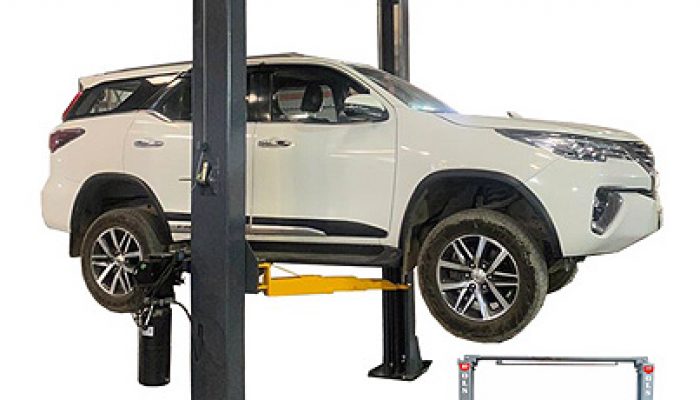Many tasks fall to fleets, including managing cars and personnel, as well as supplying the necessary tools and shop equipment to maintain the vehicles. One of the most frequent and productive pieces of shop equipment for a fleet is a two-post above-ground lift.
However, before making a purchase, it’s critical to think about the characteristics you’ll need for your business.
Comparison to other types of lifts
While some people prefer the comfort of driving on a four-post, scissor, or parallelogram lift, a two-post lift takes up less shop space when compared to these lift types. There’s also no need to buy optional wheels-free rolling jacks for tyre maintenance because so much work is done with the tyres hanging free. Consider the wide-open work areas provided by a two-post lift vs a drive-on lift, since drive-on lift runways usually tend to get in the way while repairing brake lines and other under-vehicle components. Because a two-post lift has no under-vehicle impediments, under-vehicle access is unrestricted.All safety regulations must be followed regardless of the kind of lift.
When choosing the right two-post, there are a few things to keep in mind.
1. Lifting power — The capacities of two-post lifts range from 6,000 to 30,000 pounds. This does not always imply that the vehicle’s complete weight is distributed equally. When the lift is lifted, the bulk of the weight may be in the front or back of the vehicle.
For example, a Ford F-450 equipped with a welder, tools, or a one-man bucket may weigh 11,000 pounds, yet more than half of that weight is in the back part of the truck. Because no individual arm of any two-post lift is designed to lift more than one fourth of the whole lift’s rated capacity, not over-loading the swing arms is a key safety problem if the rear axle weights 7,800 lbs.
2. Column design — Previously, all lifts were created from forklift C-shaped channels to emulate the design of forklifts that go up and down hundreds of times every day. Years ago, some lift manufacturers made the switch to a much lighter design, abandoning the type-C forklift mast with sealed roller bearings in favour of bent sheet metal columns with plastic bearings in place of sealed bearings. The lift industry’s lighter designs followed in the footsteps of the floor jack industry, transitioning from a piece of equipment that lasted forever to one that was “disposable” every few years. There are various manufacturers who use the lighter design approaches, as well as some who continue to use the classic C-shaped channels in their lifts. The superior quality of the product is reflected in the significantly longer warranties offered by these producers.
3. Lifting technique – Vehicle lifts come with a variety of lifting choices, including direct drive, chain, and cable lifts. Direct drive lifting, like the column design shown above, reduces the all-too-common wear of a cable lift. Shops incur costs as a result of worn cables and cable pulleys, which include bay downtime, service calls, and cable/pulley replacements every few years. Manufacturers who use a direct drive lift system, on the other hand, have removed the wear caused by a cable/pulley system. Manufacturers who use a chain lifting system have a lot of advantages.
4. Manufacturer’s Guarantee – The lifts under consideration are built in accordance with the manufacturer’s warranty. A better-made machine, like anything else, lasts longer. We’ve seen warranties as long as 25 years and as low as one year in the two-post lift industry.
5. Safety features – We’ve all heard it a thousand times: never use a jack without a jack stand. Lifts are no exception, and they should be lowered upon the mechanical safety locks at all times. But how can you know if the lift has been lowered upon the locks by your techs? The answer is a weight gauge, which is a pressure gauge calibrated to the vehicle’s weight. Your techs are appropriately operating the lift if the weight gauge shows zero. To signify that the lift has been lowered upon the locks, other manufacturers utilise alternative mechanisms. The weight gauge can also be used to verify service. If a customer complains about a terrible tune-up or the car tugging, you may put it on the lift to demonstrate the actual vehicle.
Conclusion
The correct two-post lift can help you increase your shop’s productivity and profits. Examine the variations between lift brands, how they’re manufactured, the guarantees they give, and the components they’re made of before making your next buy. With this additional study, you’ll be proud of your next lift purchase rather than regretting it in a few years. You can consider Oil Lube Systems lifts for a great lifting experience.

